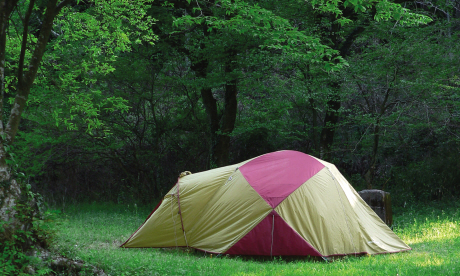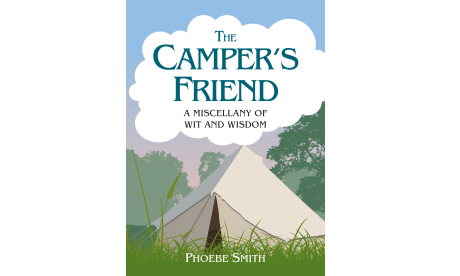
Camping enthusiast and travel writer Phoebe Smith runs through the simple yet essential rules to camping in the British wilderness
Campsites are great. You get flushing toilets, hot showers, a place to park the car and sometimes even a shop to buy your supplies. They’re convenient, they’re friendly, but… here’s the thing: everyone knows where they are. Camping is supposed to be about enjoying the outdoors and getting back to the simple life, surrounded by nature, but that’s pretty hard to do when to even get to your tent you have to negotiate a family game of rounders and trip over a rambunctious dog, and then fall asleep to your neighbours’ snoring.
So how do you enjoy all the best of camping with none of the people? The answer is wild camping. The premise is simple: choose your area, pack your tent and head into the landscape, map in hand for a night (or several) out under the stars.
No campsites, no other people, no problems.
There’s a real history of mountaineers and walkers sleeping in the UK hills and, thanks to the Land Reform Act 2003, in Scotland wild camping (done properly – see below) is still perfectly legal. That’s also the case in Dartmoor, where the right to wild camp falls under the National Parks and Access to the Countryside Act 1949. Elsewhere you’re supposed to ask the landowner’s permission before sleeping on their land, but it is usually tolerated provided you remain discreet and follow the basic wild camp etiquette.
Arrive late and leave early: Plan to arrive at your chosen location as it’s going dark and be packed up and away by the time other walkers are out and about.
Never light an open fire: A lot of places suitable for wild camping present a high risk of fi re so never do this; you don’t want to be responsible for destroying acres of beautiful landscape and devastating ecosystems!
Leave no trace of your camp: Make sure you carry out your rubbish; you should leave the site as you found it.
Be considerate of others: Respect the privacy and livelihood of others; if asked to move on, do so, and keep away from main tracks and paths.
Camp high: Stay on ground that’s well away from people’s property and keep it discreet and you should have no problems.
Choose your toilet carefully: Find a sheltered spot at least 50 metres away from water and downstream of popular camping areas. Dig a 6–8-inch deep hole, and replace the earth once you have finished your business. Remember to carry out your toilet roll with your other rubbish.
If it’s your first time, you’ll sleep a lot more soundly doing it somewhere you know it’s legally allowed:
Nestled in the wilds of south Devon, in the south-west of England, this vast and rough granite moorland offers endless possibilities for wild camping and exploration. It’s famous for its weather shaped tors – rocky boulder-like outcrops that stud the hilltops and attract peregrine falcons, which add an atmospheric air to the place – and is laced with snaking rivers cutting dramatically through the landscape. Thanks to its geographical location the weather here tends to be better than other high places in the UK and you can camp in most places within the park – it’s a case of grabbing your map and plotting your route. But a great option is to head north from Ivybridge.
En route you can check out the longest known stone row in the world on Erme Plains before heading to Higher Hartor Tor for stunning views and a possible night out under the stars. For tips on where to camp, any seasonal restrictions and military firing times check out www.dartmoor-npa.gov.uk.
With so much stunning scenery to choose from throughout the country, no matter where you go you’re sure to have a memorable evening. The Southern Uplands – including the tarns (small mountain lakes) around the highest peak, the Merrick – are great for stargazing, being the place in the UK furthest from light pollution.
The mountains around Glen Coe are steeped in legend and history – from the pyramidal Buachaille Etive Mòr to the Lost Valley, they are a perfect place to bed down surrounded by soaring peaks. Or you could choose a beach like Sandwood Bay in the far north – it’s over a mile long and has no road access and its golden sand dunes offer a multitude of pitching opportunities – and if you’re lucky you might even spot the Northern Lights.
It’s good to scope out your potential pitch first by looking on a map before you leave home so at least you have somewhere to aim for. Here’s what to look out for on an OS Explorer map (1:25,000):
Green slashes: These indicate a bog, and as well as spelling a soggy night for you they can also mean midges, so avoid them.
Blue lines: These show rivers (or blue patches for larger tarns/ lakes); being close to one is always handy to source water for cooking and drinking, meaning you don’t have to carry in much, though you should always boil water first.
Broken lines: These indicate paths and tracks. Wild camping is tolerated as long as people are discreet, so avoid these to make sure you stay out of sight.
Wobbly black clusters: These indicate the curves of corries or crags. Look for patterns of these that form a C-shape, which will shield you from high wind.
Compared to walking at night in any big city, wild camping is perfectly safe. I have done it myself many times, even on my own, and never experienced any problems. Take the usual precautions of telling someone what you’re doing, where you’re going and when you should be back, but there’s no need to worry.
Have fun and enjoy the experience! If you don’t feel happy about it, head home: it’s supposed to be for pleasure – not a challenge.
You know you're a wild camper when...
... someone has to politely point you to the toilet block when you start to dig a hole to ‘do your business’.
You should stick to campsites if...
… your idea of camping is taking a four-man tent, flocked air mattress and a double-hob cooker – even when camping alone.
 These top tips on wild camping have been taken from Phoebe Smith's recent book The Camper's Friend: A Miscellany of Wit and Wisdom, which offers all the information, advice and information you could need to head out and pitch up. The Camper's Friend: A Miscellany of Wit and Wisdom is available to buy on Amazon now.
These top tips on wild camping have been taken from Phoebe Smith's recent book The Camper's Friend: A Miscellany of Wit and Wisdom, which offers all the information, advice and information you could need to head out and pitch up. The Camper's Friend: A Miscellany of Wit and Wisdom is available to buy on Amazon now.
In praise of wild camping. Or why camping trumps a five-star hotel every time | Blogs... More
England's top 10 cool campsites | Inspire me... More
Take a look at Wanderlust's United Kingdom travel guide for more outdoor inspiration | Plan a trip... More
5 tiny campsites to squeeze into | Inspire me... More
A camping and hiking weekend in Norway | Destinations... More